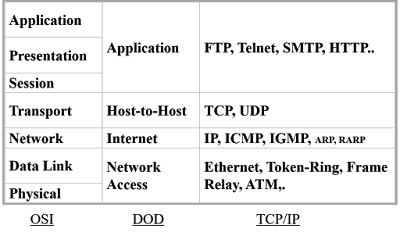What is protocol in networking?
Protocol in networking deals with all aspects of networking. Protocol is some set of rules, by maintaining those rules one network device can communicate with another network device.
Example of networking protocol- TCP/IP, IPX/SPX, NETBEUI, ETC.

TCP/IP vs OSI model
As we know OSI model is the base of networking. Here we will understand how TCP best suit on OSI model. TCP stands for Transmission Control Protocol and IP stands for Internet Protocol. TCP/IP is a protocol suit. That means it contain many protocols. Each protocol has different functionality. Lets discuss some important protocol to understand it.
Internet Layer Protocols
- IP ( Internet Protocol)- A connectionless unreliable protocol that is part of the TCP/IP protocol suite refer logical address of network node.
- ARP (Address Resolution Protocol)- Resolves IP addresses to MAC addresses
- RARP (Reverse Address Resolution Protocol)- Resolves IP addresses to MAC addresses
- ICMP (Internet Control Message Protocol)- this provide Diagnostics, error reporting with echo reply through Packet Internet Groper (Ping), tracert etc.
- IGMP (Internet Group Management Protocol)- Management of group multicast.
Transport Layer Protocols
TCP ( Transmission Control Protocol )One-to-one and connection-oriented reliable protocol. Used in the accurate transmission of large amount of data. Slower than UDP because of additional error checking being performed.
UDP ( User Datagram Protocol )One-to-one or one-to-many, connectionless and unreliable protocol. Used for small amount of data transmission. no Accuracy and no overhead of establishing a TCP connection. Used in video and audio casting(Multicasting & Broadcasting), Faster compared to TCP.
Basic different between TCP & UDP protocol
| TCP | UDP |
| Sequenced | Not sequenced |
| Reliable | Unreliable |
| Connection-oriented | Connectionless |
| Virtual circuit | Low overhead of connection |
| Acknowledgments | No acknowledgment |
| Windowing flow control | No windowing or flow control |
Logical Port: TCP & UDP requires port numbers on the host and destination for process to process communication. There are 1024 well known ports (max port 16bit=65535). Standard port numbers have been assigned by the Internet Assigned Number Authority (IANA)Some protocol and its port number-
- FTP- 20(DATA)/21(CONTROL)
- SSH- 22TCP
- TELNET- 23/TCP
- SMTP 25/TCP
- TIME 37/TCP
- DOMAIN(DNS) 53/TCP/UDP
- TFTP 69/UDP
- HTTP 80/TCP
- POP3 110/TCP
- NTP 123/UDP
- IMAP 143/TCP
- IPX 213/UDP
- LDAP 389/TCP
- HTTPS 443/TCP/UDP
- IMAPS 993/TCP
- POP3S 995/TCP/UDP
- L2TP 1701/UDP
- PPTP 1723/TCP
Application Layer Protocol
- HTTP (Hyper Text Transfer Protocol)– This provide browsing facility for multimedia related files over the internet.
- HTTPS ( Secure HTTP)– This provide secure browsing & access facility for multimedia related files over the internet.
- FTP (File Transfer Protocol)– it allows to transfer files between any two machines. It provide faster data downloading facility.
- TFTP (Trivial File Transfer Protocol)– It is just like ftp but can support faster transmission, but it does not provide directory browsing facility.
- NFS (Network File System)– this protocol is specializing in file sharing between different file system.
- Telnet– This provide terminal emulation service. It allows client system to access server system in CUI mode.
- SMTP (Simple Mail Transfer Protocol)– this is used to send mail. it is mail delivery agent.
- POP (Post Office Protocol)– POP3 is used to receive mail.
- IMAP (Internet Message Access Protocol)– It is like POP, used to receive mail.
- SNMP (Simple Network Management Protocol)– collects and manipulates valuable network information.
- DNS (Domain Name System)– DNS is used to resolve a fully qualified domain name (FQDN) in to an IP address of corresponding node.
- DHCP (Dynamic Host Configuration Protocol)-assigns IP addresses information including DNS, WINS, Gateway etc. to hosts.
Conclusion- Protocol is a vast subject to learn you may access wikipedia. But to learn as a beginner to intermediate you must understand What is network protocol and you can explain Network protocol.





